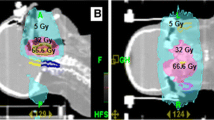Abstract
Background and purpose
Bloom syndrome is a DNA repair disorder that is hypersensitive to radiotherapy. We describe the first case in which proton beam therapy (PBT) was used in a patient with Bloom syndrome to treat oropharyngeal cancer.
Patients and methods
The patient was a 32-year-old woman with Bloom syndrome who was diagnosed with oropharyngeal cancer staged as T2N2bM0 poorly differentiated squamous cell carcinoma. The primary tumor was located on the right tongue base and extended to the right lateral pharyngeal wall. Several right upper region lymph nodes were positive for metastases.
Results
We selected PBT in anticipation of dose reduction to normal tissue. The clinical target volume was defined as the area of the primary tumor and lymph node metastases plus an 8-mm margin. After treatment with 36 GyE (Gray equivalent) in 20 fractions (4–5 fractions per week), dietary intake was decreased by mucositis and intravenous hyperalimentation was started. Termination of treatment for 2.5 weeks was required to relieve mucositis. Administration of 59.4 GyE in 33 fractions markedly reduced the size of the primary tumor, but also caused moderate mucositis that required termination of PBT. One month later, lung metastases and breast cancer developed and the patient died 9 months after PBT. At this time the reduction in size of the primary tumor was maintained without severe late toxicity.
Conclusion
We obtained almost complete response for a radiosensitive patient with a deficiency of DNA repair, indicating the excellent dose concentration of proton beam therapy.
Zusammenfassung
Hintergrund und Ziel
Das Bloom-Syndrom ist eine auf Strahlentherapie hypersensibel ansprechende Störung der DNA-Reparatur. Wir beschreiben den ersten Fall, bei dem die Protonentherapie („proton beam therapy“, PBT) zur Behandlung eines Oropharynxkarzinoms bei einer Patientin mit Bloom-Syndrom eingesetzt wurde.
Patienten und Methoden
Bei der Patientin handelte es sich um eine 32-jährige Frau mit Bloom-Syndrom, bei der ein als gering differenziertes T2N2bM0-Plattenepithelkarzinom klassifiziertes Oropharynxkarzinom diagnostiziert wurde. Der Primärtumor befand sich am rechten Zungengrund und erstreckte sich bis zur rechten seitlichen Rachenwand. An mehreren Lymphknoten im oberen Bereich auf der rechten Seite befanden sich Metastasen.
Ergebnisse
In Erwartung einer verringerten Dosisbelastung von normalem Gewebe entschieden wir uns für die Protonentherapie. Das klinische Zielvolumen wurde als der Bereich des Primärtumors und der Lymphknotenmetastasen plus einen 8-mm-Rand definiert. Nach der Behandlung mit einer Gesamtdosis von 36 GyE (Gray equivalent) in 20 Einzeldosen (4–5 Einzeldosen pro Woche) wurde die Nahrungsaufnahme infolge von Mukositis reduziert und es wurde mit intravenöser Hyperalimentation begonnen. Die Behandlung musste für die Dauer von 2,5 Wochen unterbrochen werden, um eine Linderung der Mukositis herbeizuführen. Die Verabreichung einer Gesamtdosis von 59,4 GyE in 33 Einzeldosen verringerte die Größe des Primärtumors merklich, verursachte jedoch eine milde Mukositis, die die Einstellung der Protonentherapie erforderlich machte. Einen Monat später entwickelten sich Lungenmetastasen und Brustkrebs bei der Patientin, die 9 Monate nach der Protonentherapie starb. Die verringerte Größe des Primärtumors wurde bis zu diesem Zeitpunkt ohne schwere Spättoxizität aufrechterhalten.
Schlussfolgerungen
Wir erzielten ein beinahe vollständiges Ansprechen bei einer strahlenempfindlichen Patientin mit mangelhafter DNS-Reparatur, was auf die hervorragende Dosiskonzentration der Protonentherapie hindeutet.



Similar content being viewed by others
References
Bloom D (1954) Congenital telangiectatic erythema resembling lupus erythematosus in dwarfs. Am J Dis Child 88:754–758
Pollard JM, Gatti RA (2009) Clinical radiation sensitivity with DNA repair disorders: an overview. Int J Radiat Oncol Biol Phys 74:1323–1331
Kataoka M, Kawamura M, Hamamoto M et al (1989) Radiation-induced oesophageal stricture in a case of Bloom’s syndrome. Clin Oncol 1:47–48
Ma B, Corry J, Rischin D et al (2001) Combined modality treatment for locally advanced squamous-cell carcinoma of the oropharynx in a woman with Bloom’s syndrome: a case report and review of the literature. Ann Oncol 12:1015–1017
Mizumoto M, Okumura T, Hashimoto T et al (2011) Proton beam therapy for hepatocellular carcinoma: a comparison of three treatment protocols. Int J Radiat Oncol Biol Phys 81:1039–1046
Mizumoto M, Sugahara S, Nakayama H et al (2010) Clinical results of proton-beam therapy for locoregionally advanced esophageal cancer. Strahlenther Onkol 186:482–488
Lorentini S, Amichetti M, Spiazzi L et al (2012) Adjuvant intensity-modulated proton therapy in malignant pleural mesothelioma. a comparison with intensity-modulated radiotherapy and a spot size variation assessment. Strahlenther Onkol 188:216–225
Mizumoto M, Nakayama H, Tokita M et al (2010) Technical considerations for noncoplanar proton-beam therapy of patients with tumors proximal to the optic nerve. Strahlenther Onkol 186:36–39
Leong T, Borg M, McKay M (2004) Clinical and cellular radiosensitivity in inherited human syndromes. Clin Oncol 16:206–209
Mock U, Georg D, Bogner J et al (2004) Treatment planning comparison of conventional, 3D conformal, and intensity-modulated photon (IMRT) and proton therapy for paranasal sinus carcinoma. Int J Radiat Oncol Biol Phys 58:147–154
Widesott L, Pierelli A, Fiorino C et al (2008) Intensity-modulated proton therapy versus helical tomotherapy in nasopharynx cancer: planning comparison and NTCP evaluation. Int J Radiat Oncol Biol Phys 72:589–596
Aurias A, Antoine J, Assathiany R et al (1985) Radiation sensitivity of Bloom’s syndrome lymphocytes during S and G2 phases. Cancer Genet Cytogenet 16:131–136
Kuhn EM (1980) Effects of X-irradiation in G1 and G2 on Bloom’s syndrome and normal chromosomes. Hum Genet 54:335–341
Acknowledgments
This study was partly supported by the “Funding Program for World-Leading Innovative R&D on Science and Technology (FIRST Program)” of the Council for Science and Technology Policy (CSTP).
Conflict of interest
On behalf of all authors, the corresponding author states that there are no conflicts of interest.
Author information
Authors and Affiliations
Corresponding author
Rights and permissions
About this article
Cite this article
Mizumoto, M., Hashii, H., Senarita, M. et al. Proton beam therapy for malignancy in Bloom syndrome. Strahlenther Onkol 189, 335–338 (2013). https://doi.org/10.1007/s00066-012-0274-1
Received:
Accepted:
Published:
Issue Date:
DOI: https://doi.org/10.1007/s00066-012-0274-1
Keywords
- DNA repair-deficiency disorders
- Squamous cell carcinoma
- Radiation
- Oropharyngeal cancer
- Severe acute reaction




